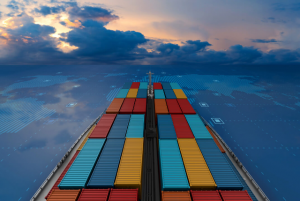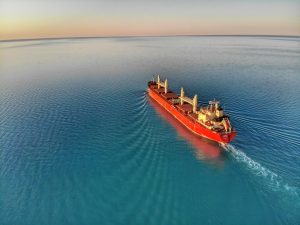by Mikael Lind, Research Institutes of Sweden (RISE), Adam Roark, AWS Transportation & Logistics, Amazon, Michele Sancricca, AWS Transportation & Logistics, Amazon, Almir Zerem, RISE, Hanane Becha, UN/CEFACT, Erminio Di Paola, HERE Technologies, Henk Mulder, IATA
Never has the need for digital data sharing and processing at scale been more apparent than now. The growth of digitally connected devices and the ever-growing complexity of digital systems provide increasing opportunities for data analytics, new digital innovations to support enhanced smartness in transport operations, and virtual near to real time learning systems, including digital twinning, to empower better decision-making. To harvest all these opportunities, this new emerging “data-driven” practice requires global approaches to robust, secured and scalable connectivity, data storage, and data processing that is offered by contemporary cloud computing providers (1). In order for actors within the maritime, as well as within the wider global transport sector, to utilise these capabilities of collaborative technologies, these providers need to offer global interoperability by adopting standardised communication frameworks agreed within the practice. This is important to enable transport operations to reach their desired economies of scale coming out of emerging shared common situational awareness for supply chain efficiency and visibility among actors within the self-organising ecosystem of maritime transport. Standardisation efforts are also important to allow for flexibility in the choice of provider, to allow for connectivity between the local data sharing environment and global connectivity, as well as to enable a seamless change management process from the fruition of traditional, on-premise IT systems to cloud based technologies.
A data-driven transformation
The maritime industry today can leverage the massive amounts of data that it has accumulated to transform the business, but new tools are needed to help easily store, process, and analyse all that data – reliably, cost effectively, and at scale. Cloud computing and data analytics, which is part of the emerging subject of maritime informatics (2), enables this data-driven transformation; it has never been easier to collect, store, analyse, enrich (using location intelligence) and share data than it is today in the cloud. IoT solutions, such as e.g. smart containers and digital twins, is becoming revolutionary data source enabling stakeholders to have better visibility, collaboration, and coordination while identifying the bottlenecks which may be opportunities for improvement and savings. In this article we explore the opportunities that cloud computing and data analytics offer the community of maritime transport actors, being a part of the global transport chain, to provide beneficial supply chain visibility for all involved.
Maritime transport arranged within a self-organising ecosystem requiring global connectivity

The maritime sector is predominantly self-organising, constituted by multiple actors that act as individual entities but also need to collaborate in order to coordinate their activities. Regardless of which role the entity occupies in the self-organising ecosystem of maritime transport, there is a need to become informed beyond on what is happening outside the scope of the operations that the entity can control. As the maritime sector does not have an overall coordination body for operational coordination and synchronisation, it becomes essential to rely on new digital streams and to perform data sharing horizontally between the actors, both on a voluntary basis, and to meet the requirements of reporting formalities (3). This also requires agreements on open standards for messaging and interfacing (4).
In order to glue the actors together in their operations and allow them to efficiently and reliably inform each other in seamless data exchanges, cloud-based digital technologies offer unique opportunities. These type of digital technologies among others provide flexible and far-reaching connectivity and data sharing capabilities across the globe, which can increase efficiency and deliver environmental benefits through a reduction in waiting times and the optimal use of energy and resources.
Within the wider transport world, we see a similar situation in air transport which due to its short journey times has seen digital integration for a long time already. However, its IT infrastructure is fragmented and many of its stakeholders are locked into legacy systems and technologies. This legacy fragmentation slows down much needed innovation, not least to allow for multimodal transport services in a fast-changing world challenged by e-commerce, COVID-19 and emerging requirements of digital natives. Initiatives like IATA’s ONE Record standard for data sharing is creating an opportunity for cloud based and collaborative developments that sparks much needed innovation and breaking open a market for new solutions that parallel what is happening in the maritime sector.
What is cloud computing?
The term “cloud computing” refers to the on-demand delivery of IT resources via the Internet, usually with pay-as-you-go pricing. Industrial data platform where data coming from different sources can be combined to improve existing processes and establish novel cognitive and AI-based applications are being developed, such as the ones being explored in the European funded FEDeRATED and Dataports projects (5). Instead of buying, owning, and maintaining their own data centres and servers, organisations can acquire technology such as compute power, storage, databases, and other services on an as-needed basis. These platforms are conceived to be scalable offering in a modular fashion a service catalogue could be extended with other services in the future. With cloud computing, providers manage and maintain the technology infrastructure in a secure environment and businesses access these resources via the Internet to develop and run the applications that best suit them and their business. Capacity can grow or shrink instantly, and businesses only pay for what they use. Notably, following the global trend towards open (as opposed to proprietary or in-house) data standards, the cloud-based technologies are based predominantly on open-standards and protocols, such that vendor lock-in and the need for users to use proprietary software and hardware solutions are avoided. The use of open standards also means that data from multiple sources can be shared, analysed and reconstituted with relative ease, regardless of its origin.
In an emerging discipline of maritime informatics uniting the industry, infrastructural capabilities for connecting, sharing data, and pursuing analytics to balance capital productivity with energy efficiency (6) is a fundamental theme needed for enabling the integrated performance within the self-organising ecosystem of shipping. Cloud computing is a promising trend that should be looked into more closely to connect actors on the global level.

What value can cloud computing and data analytics deliver to the maritime industry?
Cloud computing can deliver value to maritime companies and organisations in three phases. While not necessarily sequential, these three distinct steps deliver together, within companies and across networks of trading partners, systemic improvement of key business metrics like OPEX and assets utilization. First, by reducing IT costs. Several assets-intensive companies moved all their IT workloads to the cloud and achieved savings in the region of 50%. Second, a cloud architecture comprising of a data ingestion layer, a data lake and a client layer can enable the cheap, reliable and efficient collection, storage and analysis of data at scale (7). This enables maritime companies to break data siloes and create a single repository for their data from multiple sources at the same time as ecosystem connectivity is assured. This fully managed, pay-per-use and scalable solution takes away the complexity and costs of managing and maintaining on-premise databases. Finally, advanced technologies can be delivered on top of the ingestion and storage layers: raw data can be turned into actionable knowledge with data analytics functions such as cross-querying and business intelligence services, disseminating insights across the organisation and the ecosystem that the organisation is part of. Machine learning-based predictive and prescriptive analytics can enable just-in-time and as-required maintenance for vessels and port equipment rather than time-based scheduling, reducing downtime and failure rates. In particular those analyses bring visibility that becomes basic requirement: One of the biggest challenges within the industry is to deal with the current lack of visibility of shipments (8), which causes a poor predictability of both ETAs and ETDs. Customers expect real-time visibility in intermodal supply chains (especially for high value and time critical goods).
When you look at all the steps practitioners needs to manage across their supply-chain you find that location is relevant almost everywhere. Starting from Planning, where location can help to optimize and dynamic re-planning based on real-time data and also during execution with real-time monitoring of fleet/shipments, to identify disruptions and proactively respond to it. Beyond the global mile, Last Mile delivery can be optimized with flexible, customer-specific constraints like guaranteed delivery time, cost optimization etc. And last but not least finishing with Post-trip analysis allowing for detailed driver and job analysis to improve your future business.
Therefore with the help of cloud computing and location intelligence key metrics such as port terminal throughput or vessels’ ETD can be predicted to optimise workforce and asset utilisation. Logistics twins of global networks or complex facilities can be built, simulations run and optimal configurations prescribed to decision makers (9). A robust cloud architecture enables companies to get value out of their data with advanced analytics, blockchain, machine learning and Internet of Things (IoT), using tools that are much easier and faster than before.
The opportunity of cloud-based technologies fits well into the need for virtual integration of logistics and transport digital platforms through Linked Data where data from third parties such as partners within the logistics chain is integrated via web URL’s and API’s which provides a high degree of additional data context and transparency and facilitates cooperation in increasingly complex logistics networks.
Digital services offered by maritime transport producers enabled by cloud technologies
Cloud-based digital technologies offer innovative services that we have not seen before. As it becomes more common that physical goods being moved across the globe are equipped with IoT (10), opportunities to provide real-time tracking and status information services associated with the goods being handled becomes possible. Within the realm of smart shipping and smart ports we now see a debate associated with the capabilities of ships and shipping companies as well as ports for providing content to an emerging ecosystem of digital services. In this setting, the ability of cloud technologies to support the delivery of such services spanning over several regions is important.
Overcoming objections
Historically companies and public entities in the maritime transportation domain have been hesitant to invest extensively into digital technologies. Hence, many of them come unprepared to embrace transformative technologies such as cloud computing and data analytics, due to company culture, resources, past experience, or skills. This might slow down the process of migrating from on-premise data processing and analysis to the cloud, but adopting a phased approach to migration is a way forward. Migrating only those parts of the existing applications and IT infrastructure that are currently “cloud-ready” can be a strategy, along with a longer-term aim of replacing old legacy systems that are not cloud-compatible. Data and systems security is another major concern, which cloud computing addresses more effectively than in-house, on premise workloads. Top cloud providers have unmatched economies of scale, which translated into more resources and know-how applied to cybersecurity both at infrastructure and software level. Nowadays, institution likes financial regulators, banks, the military and governmental agencies are trusting the cloud with highly sensitive data, given cloud’s compliance with the strictest data-security standards and high level of infrastructural redundancy. Thanks to the cloud, maritime companies can take advantage of the same level of security for their businesses-critical workloads and data, while avoiding large investments into hardened facilities and hardware, physical and digital surveillance, firewalls, penetration testing and so on, since cloud provider take care of this.
Final words – cloud technologies – a data analytics opportunity for maritime informatics
The global, self-organising ecosystem of maritime transport requires integration among involved autonomous actors co-producing value to their clients. This means that the complex ecosystem of maritime transport (11) must embrace digital collaboration and data sharing, which could be empowered by cloud technologies, in order to achieve efficiency, transparency, coordination and meet community requirements for sustainability.
Informatics and data analytics show that the future for business, including in the maritime sector, is all about collaboration and data sharing. What we experience now, due to the transformation of the maritime sector into a digital society is that substantial investments made in digitalisation are already transforming the ecosystem of maritime transport. This also means that cloud computing, among other digital initiatives should be explored as a potential powerful tool to enhance cooperation, improve decision-making, and boost innovation within the maritime industry. Key to the development of integrated performance in the global ecosystem of maritime transport is the establishment of an open and globally inter-operable collaborative network, with agreed standards for communication, security and service provision being adopted by key stakeholders including different cloud solution providers.
We therefore welcome and encourage all actors in the ecosystem of maritime transports to join a discourse on technical foundations for collaborative technologies as necessary to remain relevant in the new digitalization era.

(1) Bala R., Gill B., Smith D., Wright D., Ji K. (2020) Magic Quadrant for Cloud Infrastructure & Platform Services, Gartner, 1 September 2020.
(2) Lind M., Watson R., Hoffmann J., Ward R., Michaelides M. (2020) Maritime Informatics: an emerging discipline for a digitally connected efficient, sustainable and resilient industry, Article No. 59 [UNCTAD Transport and Trade Facilitation Newsletter N°87 – Third Quarter 2020] (https://unctad.org/en/pages/newsdetails.aspx?OriginalVersionID=2456)
(3) Lind M., Renz M. (2020) Do maritime authorities have a role in digitalization of shipping? – the “Digital (port)Approach” in a sea transport context, Smart Maritime Network, 2020-07-02 https://smartmaritimenetwork.com/wp-content/uploads/2020/07/The-digital-approach-in-context.pdf)
(4) Lind M., Renz M. (2020) Do maritime authorities have a role in digitalization of shipping? – the “Digital (port)Approach” in a sea transport context, Smart Maritime Network, 2020-07-02 https://smartmaritimenetwork.com/wp-content/uploads/2020/07/The-digital-approach-in-context.pdf)
(5) DataPorts H2020 project https://dataports-project.eu/
(6) Lind M., Watson R., Chua C. P., Levy D., Theodossiou S., Primor O., Picco A. (2020) A Primer for a Profitable and Sustainable Maritime Business, Smart Maritime Network, 2020-09-09 (https://smartmaritimenetwork.com/2020/09/09/prime-considerations-for- shipping-success/)
(8) Lind M., Gogh van M., Becha H., Kouwenhoven N., Lehmacher W., Lund E., Mulder H., Murphy N., Simha A. (2020) Information Sharing Communities for Digitally Enabled Supply Chain Visibility, Article No. 64 [UNCTAD Transport and Trade Facilitation Newsletter N°88 – Fourth Quarter 2020] (https://unctad.org/news/information-sharing-communities-digitally-enabled-supply-chain-visibility)
(9) Lind M., Becha H., Watson R. T., Kouwenhoven N., Zuesongdham P., Baldauf U. (2020) Digital twins for the maritime sector, Smart Maritime Network, 2020-07-15 (https://smartmaritimenetwork.com/wp-content/uploads/2020/07/Digital-twins-for-the-maritime- sector.pdf)
(10) Becha H., Frazier T., Lind M., Schröder M., Voorspuij J. (2020) Smart Containers and Situational Awareness, Smart Maritime Network, 2020-08-12 (https://smartmaritimenetwork.com/2020/08/12/the-cargo-owners-case-for-smart-containers/)
(11) Ward R., Bjørn-Andersen N. (2021), The Origins of Maritime Informatics, in M. Lind, M. Michaelides, R. Ward, R. T. Watson (Eds.) Maritime Informatics (chapter 1), Springer.
About the authors
Mikael Lind is Associate Professor and Senior Strategic Research Advisor at Research Institutes of Sweden (RISE) and has a part-time employment at Chalmers University of Technology, Sweden. He serves as an expert for World Economic Forum, Europe’s Digital Transport Logistic Forum (DTLF), and UN/CEFACT.
Adam Roark is WorldWide Transportation & Logistics Industry leader with AWS and has gained more than 30 years of experience in the Transportation & Logistics industry, having lived and worked in Asia for 10 years all focused in the Transportation & Logistics Industry, with roles across both business, consulting, and technology.
Michele Sancricca is the Worldwide Head of Technology for Transportation and Logistics at AWS. Previously he worked as Head of Supply Chain Products for Amazon Global Mile and as Director of Business Transformation at MSC. A retired Lieutenant Commander, Michele served 12 years in the Italian Navy.
Almir Zerem is Senior Solution Architect at Research Institutes of Sweden (RISE) with 20 years of experience from telecom and transports, both from private and public sectors.
Hanane Becha is the IoT program Project lead at DCSA and the UN/CEFACT Transport & Logistics vice chair leading Smart Container Project and Cross Industry Supply Chain Track and Trace Project. Hanane has a solid background from the IoT provider perspective, having worked at TRAXENS for many years.
Erminio Di Paola is Vice President Product Management – HERE Technologies. With over a decade of international experience from TomTom and TeleAtlas with a focus building location-based services and applications he has been with HERE for the past 9 years.
Henk Mulder is Head, Digital Cargo at the International Air Transport Association. He is the initiator and driving force behind the development of the IATA ONE Record data sharing standard and has recently launched the development of an Interactive Cargo standard for the use of IoT in air transport.





